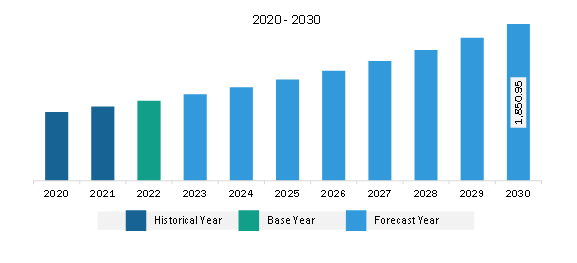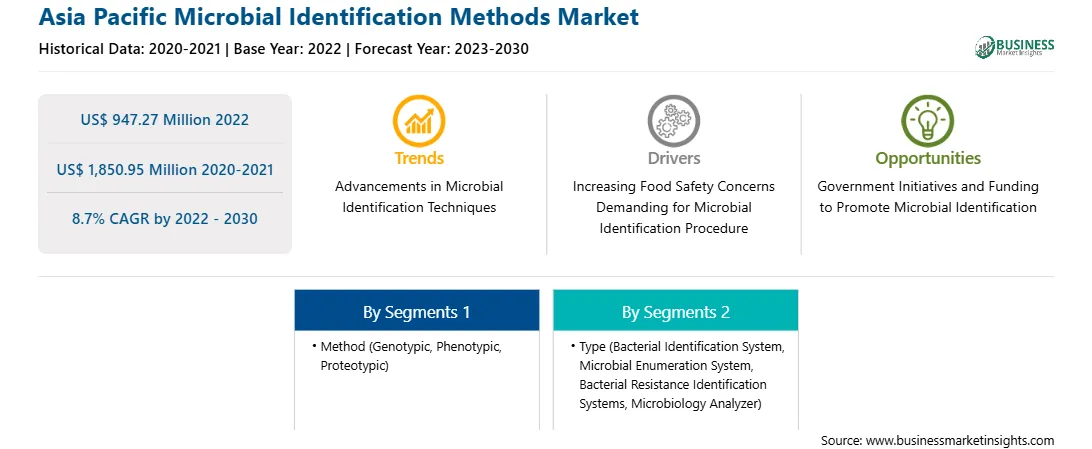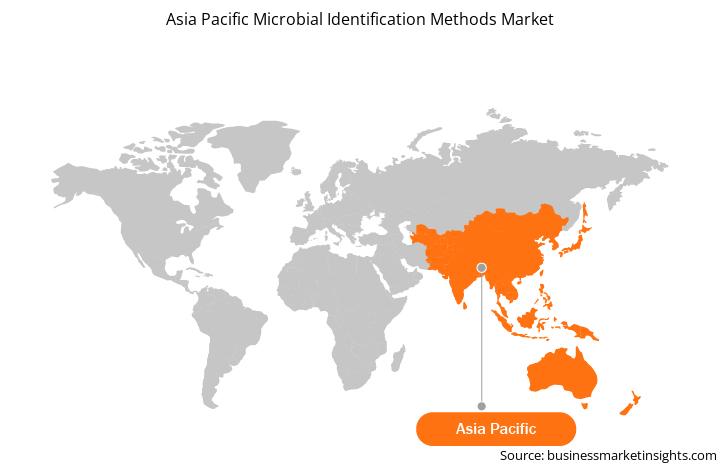The Asia Pacific microbial identification methods market was valued at US$ 947.27 million in 2022 and is expected to reach US$ 1,850.95 million by 2030; it is estimated to grow at a CAGR of 8.7% from 2022 to 2030.
Increasing Food Safety Concerns Demanding for Microbial Identification Procedure Fuel the Asia Pacific Microbial Identification Methods Market
Foodborne diseases (FBD) are a prevalent and expanding public health and economic problem. The prevalence of foodborne infections is influenced by recent changes in food production and processing methods and consumers' ever-evolving eating patterns. The interaction between known pathogens during infection is one of the concerns, and new difficulties have emerged in recent years. Despite the rising adoption of chemical preservatives, cold chains, and a greater understanding of microbes, foodborne illnesses are a significant public health issue for both industrialized and developing nations. The Food Security Cluster estimates that each year, ~420,000 people die, and over 600 million people-nearly one in ten people worldwide-get sick after consuming contaminated food, resulting in a loss of 33 million DALYs in June 2022. With an estimated 4.1 million cases of foodborne illness each year and an estimated $1.2 billion in costs, foodborne disease is a major problem in Australia. Over the past 20 years, Australia has had a considerable increase in foodborne illness caused by Salmonella, and one of the highest rates of this infection when compared to several similar countries. An estimated 56,200 cases of salmonellosis were reported, of which 2,100 result in hospitalizations and 15 are fatal. Of these, 72% are considered to be foodborne. Also, according to Asian Development Bank projections, 4.7 million people in Southeast Asia were living in poverty in 2021, which made it more difficult for them to obtain safe food and other requirements. Foodborne disease is more common in Southeast Asia as a result of these.
The conventional approach is cultivating bacteria using a variety of nonselective and selective enrichment techniques, followed, among other things, by biochemical confirmation. The time-to-detection is a significant limitation when testing foods, especially those with short shelf lives like fresh meat, fish, dairy products, and vegetables. Several newer detection methods use spectroscopic approaches, such as matrix-assisted laser desorption ionization-time of flight and hyperspectral imaging protocols. Thus, the increase in cases of foodborne diseases is driving the Asia Pacific microbial identification methods market.
Asia Pacific Microbial Identification Methods Market Overview
Asia Pacific comprises countries such as China, India, Japan, Malaysia, Indonesia, South Korea, and others. The rising infectious diseases in Asia Pacific drive the growth of the Asia Pacific microbial identification methods market. According to a study published (2023) in Frontiers in Public Health, the number of incident cases of lower respiratory infections increased from 414.3 million in 1990 to 488.9 million in 2019, with South Asia, East Asia, and Southeast Asia having the largest incident cases. Similarly, according to the report by One Health Trust in 2021, the Southeast Asian population is vulnerable to neglected tropical diseases alongside emerging infectious diseases from arbovirus infections, dengue, chikungunya, Japanese encephalitis, and the continuing concern of influenza outbreak. Further, China reported an exponential rise in the incidence of human brucellosis from 2020 to 2021. As per a report published by the Chinese Center for Disease Control and Prevention, 69,767 brucellosis cases were reported from 2,083 county-level divisions in 2021, a 47.7% increase from 2020, i.e., 47,425. In 2017, the Chinese Pathogen Identification Net (China PIN) was developed to collect data on bacterial pathogens from the network laboratories to support the early detection and tracing of infectious diseases.
The infectious disease burden in India is high, and patients are mainly from the rural population. As per the Ministry of Health and Family Welfare (MoHFW), more than 40% of the population in India carry TB bacteria in their body. Out of the total incidence of TB worldwide, more than 26% are from India, including both multidrug-resistant TB and HIV TB cases. In addition, the Institute for Health Metrics and Evaluation stated that Malaysia and Indonesia have a high prevalence of lower respiratory infections such as acute bronchitis and pneumonia. Similarly, as stated in a study published (2023) in PubMed Central, acute diarrhea is a major public health problem in Malaysia, with more than 13.5 million cases reported annually. Out of these, ~5% of cases occur in children under five years. Thus, the high prevalence and rising incidence of various infectious diseases will increase pharmaceutical production and diagnostics, boosting the demand for microbial identification methods in the region. The market is witnessing significant growth in various countries in the rest of Asia Pacific due to the rising demand for pharmaceutical production, infectious disease diagnosis, and increasing collaborations to improve the healthcare industry in Asian countries. The healthcare industry in Singapore has evolved enormously due to the highly skilled workforce, advanced healthcare infrastructure, and favorable government policy initiatives. Countries such as Singapore and Thailand are also developing their healthcare systems and emerging as excellent medical tourism destinations. Thus, the demand for diagnostics and related healthcare requirements in the rest of Asia Pacific is expected to fuel the Asia Pacific microbial identification methods market in the coming years.
Asia Pacific Microbial Identification Methods Market Revenue and Forecast to 2030 (US$ Million)

Strategic insights for the Asia Pacific Microbial Identification Methods provides data-driven analysis of the industry landscape, including current trends, key players, and regional nuances. These insights offer actionable recommendations, enabling readers to differentiate themselves from competitors by identifying untapped segments or developing unique value propositions. Leveraging data analytics, these insights help industry players anticipate the market shifts, whether investors, manufacturers, or other stakeholders. A future-oriented perspective is essential, helping stakeholders anticipate market shifts and position themselves for long-term success in this dynamic region. Ultimately, effective strategic insights empower readers to make informed decisions that drive profitability and achieve their business objectives within the market.

| Report Attribute | Details |
|---|---|
| Market size in 2022 | US$ 947.27 Million |
| Market Size by 2030 | US$ 1,850.95 Million |
| Global CAGR (2022 - 2030) | 8.7% |
| Historical Data | 2020-2021 |
| Forecast period | 2023-2030 |
| Segments Covered |
By Method
|
| Regions and Countries Covered | Asia-Pacific
|
| Market leaders and key company profiles |
The geographic scope of the Asia Pacific Microbial Identification Methods refers to the specific areas in which a business operates and competes. Understanding local distinctions, such as diverse consumer preferences (e.g., demand for specific plug types or battery backup durations), varying economic conditions, and regulatory environments, is crucial for tailoring strategies to specific markets. Businesses can expand their reach by identifying underserved areas or adapting their offerings to meet local demands. A clear market focus allows for more effective resource allocation, targeted marketing campaigns, and better positioning against local competitors, ultimately driving growth in those targeted areas.

1. Avantor Inc
2. Becton Dickinson and Co
3. bioMérieux SA
4. Bruker Corp
5. Danaher Corp
6. Merck KGaA
7. Molzym GmbH & Co KG
8. Shimadzu Corp
9. Thermo Fisher Scientific Inc
10. Biolog, Inc.
The Asia Pacific Microbial Identification Methods Market is valued at US$ 947.27 Million in 2022, it is projected to reach US$ 1,850.95 Million by 2030.
As per our report Asia Pacific Microbial Identification Methods Market, the market size is valued at US$ 947.27 Million in 2022, projecting it to reach US$ 1,850.95 Million by 2030. This translates to a CAGR of approximately 8.7% during the forecast period.
The Asia Pacific Microbial Identification Methods Market report typically cover these key segments-
The historic period, base year, and forecast period can vary slightly depending on the specific market research report. However, for the Asia Pacific Microbial Identification Methods Market report:
The Asia Pacific Microbial Identification Methods Market is populated by several key players, each contributing to its growth and innovation. Some of the major players include:
The Asia Pacific Microbial Identification Methods Market report is valuable for diverse stakeholders, including:
Essentially, anyone involved in or considering involvement in the Asia Pacific Microbial Identification Methods Market value chain can benefit from the information contained in a comprehensive market report.